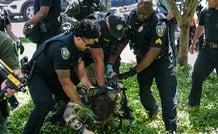President unconstitutionally claims “total decision-making power” when the economy reopens. In the east and west, the real decision-makers, the governors, coordinate their next steps.
In the US federal system, governors largely have a say about what is happening in their member states. The constitution is in its tenth addition Clear: All powers that have not been transferred to the central government or removed from the member states remain with the states or the people. It is no coincidence that the President is not listed here. Like the other nine constitutional amendments, which were ratified as the “Bill of Rights” in 1791, the tenth expressly revolves around strengthening the rights of member states and individuals concerning central power.
Bearer of the good news
Since he too understood the seriousness of the Covid-19 pandemic, President Donald Trump has been trying to stage himself as the one who saves lives and helps the economy get back on its feet. He likes to leave the bad news to others. Noticeably rarely does he comment on the sometimes draconian restrictions on freedom of movement that the governors imposed in the member states?
Trump prefers the role of the patron who decides on the allocation of resources. And he made it clear that he would make it dependent on the level of deference the governors show him. This is another reason why the member states themselves hunted for medical equipment but often had to outdo each other.
When the worst seemed to be over on the west coast, The governors of California, Oregon, and Washington sent hundreds of vital ventilators to New York and other states struggling with high death rates. It was the clearest demonstration that the governors had taken over. Perhaps this was the reason why Trump played the big Zampano in his daily performances, disguised as information events about the fight against the epidemic. On Monday, he then ventured to claim that he had “total decision-making power” as president in connection with the virus pandemic.
The media were mostly horrified, and New York governor Andrew Cuomo reminded the day after that there was no king in the United States. The president had come to his senses at that time and was holding talks with all 50 governors about stimulating the economy.
Trump is determined to go down in history as the man who heralds the return to normality, who announces the good news. That’s the only reason why he assumes powers that he doesn’t have: he doesn’t want governors – democratic ones too – to steal the show. But that is exactly what has already started, and it is only logical. Since the governors passed the restrictive provisions, it is their job to relax them again. And since the coronavirus doesn’t care about national borders, several of them have started to consult with their neighbors.
6 criteria to relax restrictions
California, Oregon, and Washington on the west coast and New York, New Jersey, Connecticut, Pennsylvania, Delaware, Rhode Island, and Massachusetts on the east coast want to coordinate the easing of restrictions closely. The three West Coast governors, Gavin Newsom, Kate Brown, and Jay Inslee, have already agreed on six criteria that will be used when deciding when and where to loosen restrictions.
First of all, it must be ensured that tests can be carried out quickly and over a wide area, that the older and more vulnerable population receives protection and that hospitals can cope with any further outbreaks. This also includes determining successful treatment methods.
Furthermore, the three states want to develop guidelines that should allow schools and companies to adhere to distance rules despite their reopening. Also, they want to develop an early warning system that uses data tracing to provide decisive information if a new restriction on freedom of movement becomes necessary.
In New York, where the death toll for the city alone rose to over 10,000, the level of infection seemed to be stabilizing for the first time. However, Governor Cuomo made it clear on Wednesday that there could be no return to normal as long as there was no reliable vaccination or treatment. And a gradual relaxation of the restrictions will extend over many months: “There is no light switch.”










